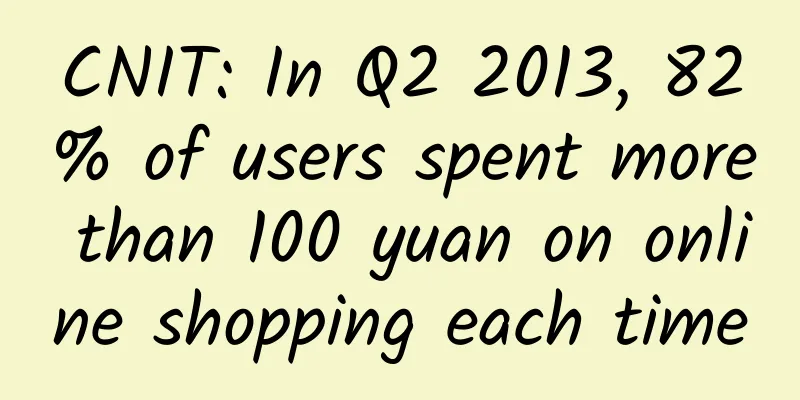CNIT: In Q2 2013, 82% of users spent more than 100 yuan on online shopping each time

|
CNIT-Research (China IT Research Center) analyzed the online shopping behaviors of online shoppers in the second quarter of 2013 and found that more than 82% of online shoppers mainly learned about online shopping information through friends or the media, and 81% of users spent an average of 100-500 yuan on online shopping at one time, with clothing, shoes and hats being the main items purchased online. The survey results show that most online shopping users learn about online shopping information through friends or the media. In the survey on "What is the main way to learn about online shopping information?", 36.5% of online users said that they mainly learn about it through friends, ranking first. The total proportion of learning through the media and advertisements reached 45.7%, indicating that media as a way for users to learn about online shopping information should not be underestimated (as shown in Figure 1). Figure 1: Users mainly learn about online shopping information through friends or the media Regarding the familiarity of Internet users with online shopping operations, 38% are generally familiar, 33% are familiar, 11% are very familiar, and 13% are not very familiar. In addition, 5% of Internet users still need guidance from others to complete online shopping operations. This shows that Internet users' proficiency in online shopping operations needs to be improved. Simplifying the online shopping operation process will make users' online shopping more convenient (as shown in Figure 2). Figure 2: Familiarity with online shopping operations What is the average amount of money that online shoppers spend at one time? CNIT-Research found that the majority of online shoppers spend 100-500 yuan, of which 100-200 yuan accounts for 41.3%, and 200-500 yuan accounts for 39.7%. Online shoppers who spend less than 100 yuan also account for 16.1%, while those who spend 500-1,000 yuan and more than 1,000 yuan account for 7.6% and 5.3% respectively. This shows that the average amount of money that online shoppers spend on online shopping is relatively small, and low-priced goods still dominate online shopping (as shown in Figure 3). Figure 3: Average amount spent on online shopping Regarding the frequency of online shopping, most online shoppers chose "it depends", indicating that online shopping is very casual, accounting for 58%. In addition, the highest proportion of users answered "about once a month", accounting for 28%, and another 9% chose "about once a week", and 5% chose "about once every six months" (as shown in Figure 4). Figure 4: Online shopping frequency The survey and statistics on the proportion of online shopping expenditure to total shopping expenditure show that more than half of online shoppers spend less than 5% of their total shopping expenditure, reaching 57%. 21% of online shoppers spend 5-10% of their total shopping expenditure, 16% spend 10-20% of their total shopping expenditure, and 6% spend more than 20% of their total shopping expenditure (as shown in Figure 5). It can be expected that the proportion of online shopping expenditure to total shopping expenditure will continue to increase, and the proportion of online shopping market transaction scale to the total retail sales of consumer goods will continue to increase. Figure 5: Proportion of online shopping expenditure in total shopping expenditure The survey statistics on "What types of goods are usually purchased online" show that 76.3% of online shoppers chose clothing, shoes and hats, ranking first. The others, in order of proportion of online shoppers, are: textiles and chemical fibers, agriculture, forestry and animal husbandry, digital home appliances, machinery and equipment, chemicals and plastics, food, sugar and alcohol, construction and building materials, hardware tools, and medical and pharmaceuticals (as shown in Figure 6). Figure 6: What types of goods are usually purchased online It is not difficult to see from the above figure that various types of commodities are divided into three levels in the choices of online shoppers. Clothing, shoes and hats are at the first level; more than 30%-40% of online shoppers chose textiles and chemical fibers, agriculture, forestry and animal husbandry, and digital home appliances, which are at the second level; the others are at the third level, and the online shoppers who chose them are all below 20%. |
<<: Kitcatt Nohr Digitas: Travel brands need to understand what consumers want
Recommend
Extremely high temperatures in both the North and South Poles! Experts: It's quite unusual
According to foreign media reports, the Earth'...
Does American ginseng contain estrogen?
As a medicinal material, American ginseng only pl...
Developing rockets and satellites and training astronauts, what is the potential for Russian-North Korean space cooperation?
Recently, Russian officials said that the Russian...
Scientists have found the largest galaxy. How big is it? It will subvert your imagination
Recently, scientists discovered a giant galaxy in...
Want to avoid immune "surveillance"? No way! Zhejiang University's latest research published in Nature
Lactic acid plays an important role in human heal...
The efficacy and function of Hongji Kicking Incense
Red Chicken Kicks Fragrance is a common Chinese m...
The efficacy and function of Yunnan deer tooth vegetable [picture]
Yunnan deer tooth vegetable [picture] is somethin...
A long-standing question: Can mobile hard drives and USB flash drives be hot-swapped? | Digital Literacy
Audit expert: Zheng Yuanpan Professor of Zhengzho...
It's jué! A large group of "fern seeds" appeared on the beach in Shanghai!
Yesterday, a tweet saying "Shanghai's la...
The efficacy and function of dragon tongue leaf [picture]
For the Chinese medicinal material such as dragon...
Luotu Technology: In August 2023, the export volume of monitors from mainland China will reach 12.5 million units, an increase of 11.6% year-on-year
According to data released by RUNTO, in August 20...
1001.42 meters! Why is the world's first well over a thousand meters deep called the "Great Well"?
About 200 million years ago, Zigong was in a crit...
What Chinese medicine is good for enteritis?
If gastrointestinal diseases occur in life, it mu...
Is there a connection between dog breed and personality?
© Bettmann/Getty Leviathan Press: We often make v...









